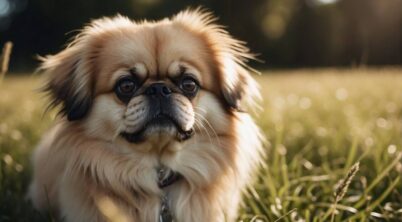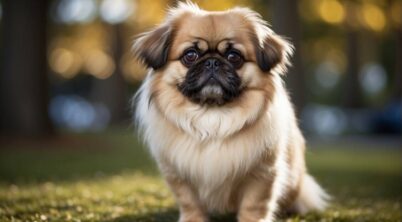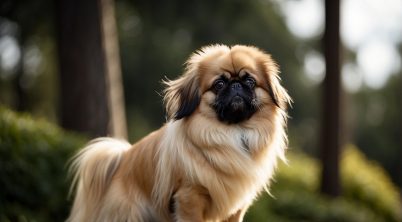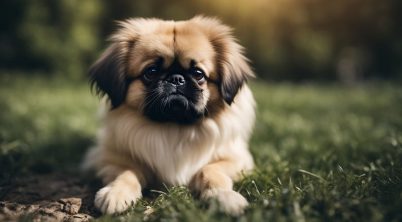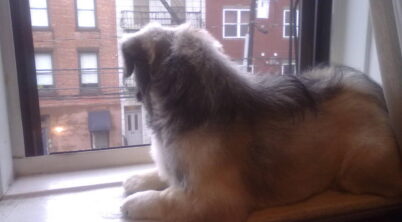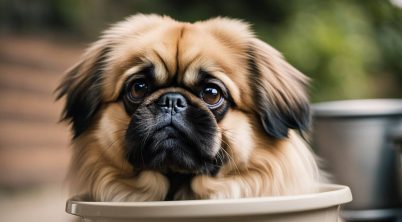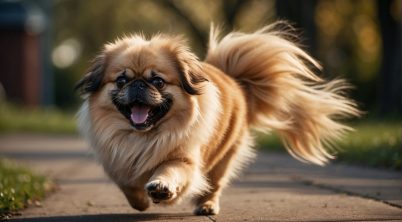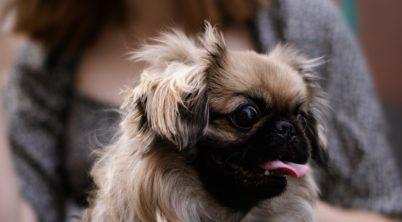The Pekingese is a breed rich with history, tracing its origins back to ancient China, where it was held in high esteem by Chinese royalty. Known as the “lion dog” for its resemblance to Chinese guardian lions, the breed gained Western fame when several were taken from the Summer Palace during the Second Opium War in 1860 and one was presented to Queen Victoria, further cementing their status as dogs of nobility. Their deeply rooted heritage is characterized not only by their distinctive physical appearance but also by their regal demeanor.
Pekingese are known for their unique physical features, such as their short faces and domed heads, characteristics that define the breed but also lead to a host of health concerns. Brachycephalic—or having a short, pushed-in nose—the Pekingese suffers from related breathing complications which are compounded by their susceptibility to eye diseases, skin conditions, and orthopedic issues due to their short legs and long back. Despite these predispositions, the Pekingese endears itself to owners through its undying loyalty and spirited personality.
Owners of Pekingese should be aware of the breed’s health problems, which are a direct consequence of their physical conformation. Common ailments include skin issues, often manifesting as itching and redness, caused by parasites, allergies, or infections. Eye diseases and joint problems are also frequent concerns, demanding vigilant care and regular veterinary check-ups to manage these conditions effectively and enhance the dog’s quality of life.
Table of Contents
Pekingese Problems
Health Issues
The Pekingese breed is prone to several health concerns due to its distinctive physical features. Brachycephalic Syndrome is a critical issue, caused by the breed’s flat face, leading to breathing difficulties.
Skin conditions are also common, with symptoms such as:
- Excessive scratching
- Hair loss
- Redness and scabs
Orthopedic problems arise from the breed’s structure, especially from their short legs and long backs, making them susceptible to injuries even from simple activities like jumping.
Eye Concerns
Eye issues are prevalent due to their large, prominent eyes. These can include:
- Corneal ulcers
- Dry eye
- Cherry eye
Temperament Challenges
These dogs may experience behavioral issues such as:
- Reactivity on a leash
- Fearful behavior, necessitating patience and positive reinforcement training
Table summarizing Pekingese health problems:
| Problem Category | Specific Issues |
|---|---|
| Respiratory | Brachycephalic Syndrome |
| Skin | Allergies, Infections |
| Orthopedic | Joint Diseases, Potential Injuries |
| Ocular | Corneal Ulcers, Cherry Eye |
| Behavioral | Leash Reactivity, Fearfulness |
Owners and breeders must monitor these conditions closely to ensure the well-being of their Pekingese pets. Early detection and proper care are essential in managing these breed-specific challenges.
Breed Characteristics
This section details the Pekingese’s distinct physical characteristics and personality traits which reflect their regal history and affectionate nature.
Physical Appearance
The Pekingese is a toy breed, distinctive for its compact and stocky frame, with a typical height of 6-9 inches and a weight of up to 14 pounds. Its physical appearance is characterized by a lion-like impression, featuring a luxurious double coat that comes in various coat colors such as black, red, tan, white, and cream. The eyes of the Pekingese are large and prominent, contributing to their expressive and sometimes willful demeanor. Their fur is long and coarse, often requiring regular grooming to maintain its appearance.
Personality Traits
Pekingese are known for their personality and temperament, showcasing a set of traits that are both charming and dignified. They possess an alert and confident nature, serving well as watchdogs despite their small size. Often described as “lion dogs” or regal, they can also be quite affectionate and enjoy being lapdogs. However, they are known to be independent and opinionated which can translate into stubbornness, thus requiring patient and consistent training. Their history as dogs of royalty contributes to their dignified behavior, and while they can be affectionate, their independent nature means they might not always follow commands.
Health Concerns
The Pekingese breed, while cherished for its unique looks and character, is predisposed to a spectrum of health problems that require vigilant care. A responsible owner should be aware of these concerns and engage in regular consultations with a veterinarian to maintain the dog’s health and extend its lifespan.
Respiratory Issues
Pekingese dogs, due to their distinctive brachycephalic (short-nosed) facial structure, often struggle with breathing problems. This compacted anatomy can lead to conditions such as Brachycephalic Syndrome, characterized by obstruction of upper airways that manifest symptoms like labored breathing and snoring. Regular monitoring and avoiding excessive exercise during hot weather can prevent complications.
Ocular Conditions
Ocular health is a significant concern for Pekingese, as their prominent eyes are prone to multiple issues. Conditions including dry eye, progressive retinal atrophy which can lead to blindness, and corneal ulcers are among the more serious afflictions. Symptoms such as excessive tearing, cloudiness, or redness should prompt immediate veterinary attention to avoid long-term damage.
Orthopedic Challenges
With their compact bodies and short legs, Pekingese can experience orthopedic issues. The most common orthopedic condition in these dogs is luxating patella, where the kneecap slips out of place, causing discomfort and affecting mobility. Early detection through regular vet visits is crucial for the management of these conditions.
Other Health Problems
The dense fur of Pekingese makes them susceptible to skin allergies and skin fold dermatitis. Watch for signs of itching, redness, and irritation. Furthermore, due to their unique dental structure, Pekingese often suffer from dental disease, which makes dental hygiene paramount. Heart disease, particularly mitral valve disease, is also a concern and can be monitored through routine vet check-ups.
Grooming and Care
The Pekingese breed necessitates a diligent grooming regimen to maintain both its appearance and health. Their distinct, long coat requires regular brushing to prevent mats, and oral hygiene coupled with nail maintenance are vital aspects of their care routine.
Coat Maintenance
The Pekingese boasts a luxurious double coat that sheds seasonally and thus demands consistent grooming. Weekly brushing is the minimum requirement to keep their coat free of tangles and mats. Owners should employ a high-quality brush and comb, targeting areas prone to heavy matting such as behind the ears and under the legs. During shedding periods, more frequent brushing can help manage the increased rate of hair loss.
- Regular brushing prevents the formation of painful mats and keeps the coat clean.
- Seasonal shedding can be managed with increased grooming frequency.
Dental and Nail Care
Like all dog breeds, Pekingese need their teeth brushed regularly to maintain dental health. It is recommended to introduce teeth brushing early and use toothpaste formulated for canines. Owners should strive to clean their Pekingese’s teeth several times a week to prevent the buildup of plaque and avoid periodontal diseases.
- Daily brushing or several times a week is ideal for preventing dental issues.
- Use a dog-friendly toothbrush and toothpaste for Pekingese to get used to the process.
Nail care is equally important; long nails can lead to discomfort and mobility issues for the Pekingese. Regular trimming—typically every few weeks—is necessary to keep their nails at a comfortable length. If one can hear the dog’s nails clicking on the floor, it is likely time for a trim.
- Trim nails every few weeks or as needed to prevent overgrowth.
- Look for signs like clicking noises on hard floors to determine when it’s time for a trim.
Feeding and Nutrition
The Pekingese breed requires a well-formulated diet to maintain optimal health. Feeding them the proper amount of dog food is critical; typically, an adult Pekingese needs about 1/2 to 1 cup of dry food per day, divided into two meals. Pekingese owners should measure food portions carefully, considering the dog’s age, size, and activity level.
- Puppies: More frequent meals to support growth
- Adults: Twice daily to maintain a healthy weight
The quality of dog food given to a Pekingese is just as important as quantity. The food should be:
- Rich in nutrients
- Appropriate for their life stage
- A balance of protein, carbohydrates, and fats
Treats should be given sparingly to avoid obesity, a notable concern in this breed. A Pekingese’s diet can regulate many health issues they are prone to, including maintaining their weight to avoid additional pressure on their respiratory system.
Feeding Tips:
- Monitor weight and adjust food intake as necessary
- Opt for lower-calorie treats
- Encourage physical exercise to complement diet
Owners should understand the balance of feeding and nutrition is not only about what the Pekingese eats but also about how much and how often. Proper dietary practices are a cornerstone in preventing nutrition-related problems such as obesity or malnourishment in this breed.
Training and Socialization
When training and socializing a Pekingese, it’s important to understand their specific personality and temperament. This breed can exhibit a noble and independent attitude, which may influence their response to certain training methods. Early socialization and tailored behavioral training can help mitigate potential issues related to their strong-willed nature.
Behavioral Training
Training a Pekingese should begin at the puppy stage to ensure the best results. The American Kennel Club (AKC) suggests that this toy breed requires consistent, patient training to overcome their sometimes stubborn temperament. For effectiveness, use the following strategies:
- Positive Reinforcement: Reward desired behaviors with treats and praise to encourage repetition.
- Consistency: Stick with commands and rules to prevent confusion and ensure learning.
A Pekingese may be less inclined to participate in excessive exercise, but sessions should incorporate brief periods of play to maintain their attention. They respond well to training that is both fun and mentally stimulating.
Interaction with Others
Socializing a Pekingese is critical for their development. These dogs need to be exposed to a variety of people, environments, and other animals to develop a well-rounded temperament. Utilize these points for successful socialization:
- Start Early: Introduce your Pekingese to different people and animals early in their life to help them become more adaptable.
- Gradual Exposure: Slowly introduce new experiences to prevent overwhelming them, starting with calm environments and gradually moving to busier scenarios.
Even though the Pekingese can adapt well to living with families, careful introduction to children and other pets is necessary due to their size and potential for asserting dominance. Regular interaction helps ensure that the Pekingese remain sociable and amiable companions.

